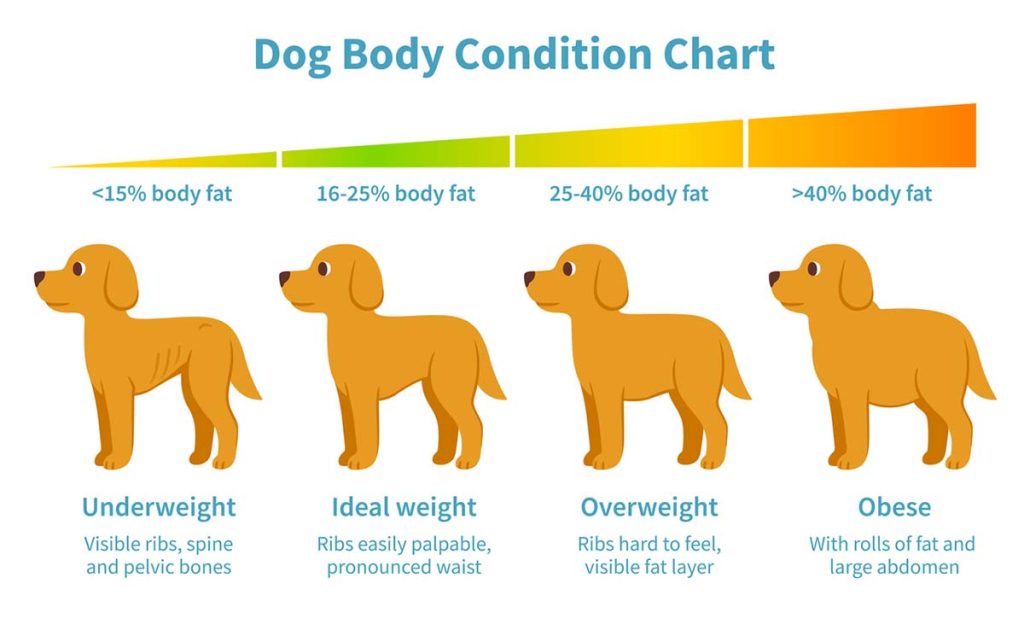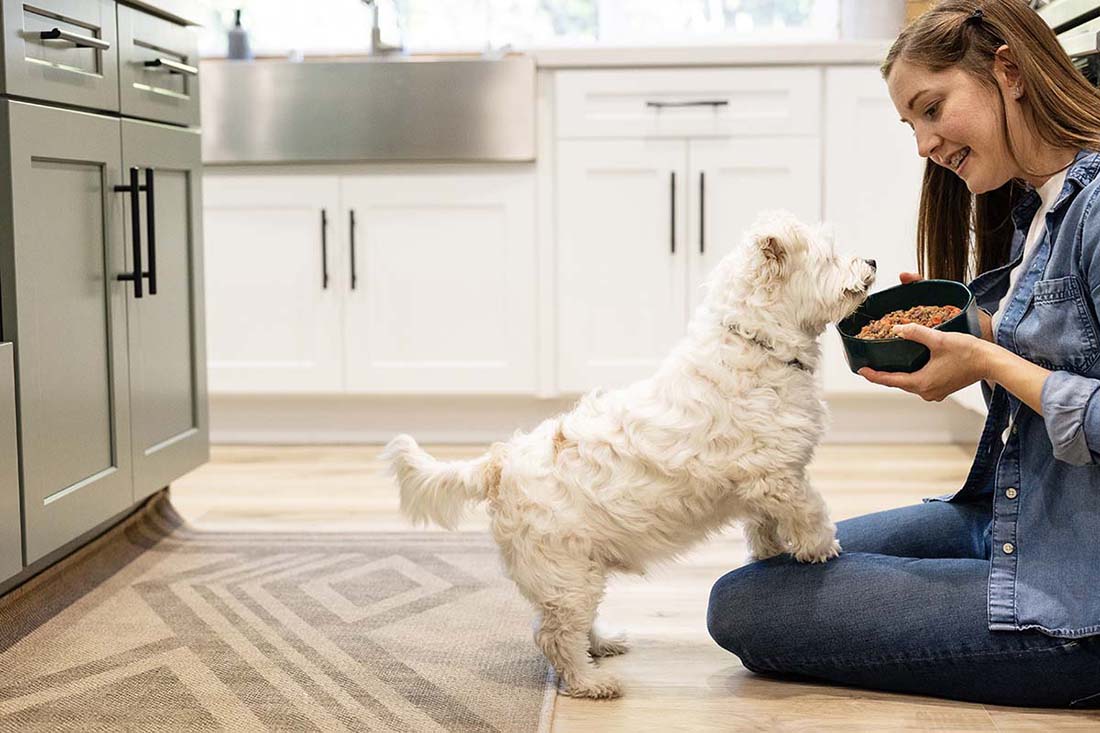Why is the question “How much should I feed my dog?” so important? Because a proper diet, balanced nutrition, and healthy body weight are critical factors in determining your dog’s present and future health.
Read on the learn more about how to determine your pup’s ideal daily caloric intake as well as what kind of feeding schedule will fit your dog’s needs.
Obesity Is Detrimental to Your Dog’s Health

In 2018, the annual survey by the Association for Pet Obesity Prevention estimated that 56% of the dogs in the U.S. (more than 50 million) were overweight or obese.
This is a critical issue for us as pet parents. Maintaining a healthy weight is vital to a long and vigorous life for our precious pets.
Studies have shown that even being moderately overweight can reduce canine life expectancy by as much as two years.
Overweight dogs face a daunting list of potential health problems such as:
- arthritis and joint disease
- heart disease
- high blood pressure
- diabetes
- decreased stamina
- increased cancer risk
- depression.
While obesity gets most of the attention, being underweight is not a great alternative either. Underweight dogs can also suffer from long-term health issues due to a lack of nutrients.
SEVEN STEPS TO A HEALTHY FUTURE
What is the best way to determine the optimum weight for your pooch and the right amount of food to maintain that weight? Here are seven steps that will help you determine the answer to the age-old question of how much should I feed my dog?
1. WEIGH YOUR DOG
Weigh your dog to determine his or her current weight. This can be done as part of a scheduled examination. If done with an exam, it’s a great time to ask your vet’s opinion on your dog’s weight and whether the amount and type of food you are serving is appropriate.
If you don’t have a vet appointment coming up, most practices will let you stop by to weigh your dog anytime.
2. DETERMINE YOUR DOG’S BODY CONDITION

One way to determine your dog’s ideal weight is to use the system used by many veterinarians: the body condition score.
The body condition scoring system lets you use sight and touch to determine where your dog stands in relation to ideal body weight. For most dogs, this means ribs, spine, and hip bones are easily felt; there is a visible abdominal tuck; and a small amount of fat can be felt under the skin.
3. UNDERSTAND DAILY FEEDING GUIDELINES
This sounds straightforward, but many feeding guidelines on dog food labels overgeneralize. No matter if it’s one meal a day, two meals, etc. Weight ranges can be listed in 15-to-25-pound increments, and feeding amounts can be pretty general as well.
For example, one dog feeding chart we checked said dogs weighing 51-75 pounds should be fed 2 ¾ to 3 ½ cups each day. That’s a pretty wide range. Remember, feeding guidelines are recommended daily feeding amounts and not per meal.
4. DETERMINE YOUR POOCH’S ACTIVITY LEVEL

Your pup’s lifestyle is another factor in determining caloric intake and nutritional needs. If your dog is a continually moving Border collie that herds the neighborhood children to the bus stop, she needs more calories than that loving couch potato whose most rigorous daily exercise is climbing onto your lap.
Active dogs need to be on the higher end of the feeding guide recommendations, while more sedentary snugglers should be on the lower end of the range.
5. FIGURE IN TREATS
Most of us give our furry family members a dog treat or two throughout the day. The rule of thumb that most veterinarians recommend is to limit your dog’s caloric intake from snacks to no more than 10% of your dog’s daily diet. This number needs to be subtracted from your dog’s daily meal calculation to avoid overfeeding.
6. DETERMINE THE QUANTITY AND FEEDING SCHEDULE
How much should my dog eat? When should mealtimes be? We are almost there, but unfortunately, there is some math involved here:
- Select the amount of calories/cups per day from your pet food’s feeding guidelines. Don’t forget to factor in your pup’s activity level in making this determination.
- Subtract the number of calories you are feeding your dog in snacks.
- Determine how often you feed your dog. Most people feed their dogs twice per day, but there is no hard and fast rule—so consult your veterinarian if you have questions.
- Divide the number of daily meals from the recommended daily feeding amount determined in steps 1 and 2 above, and voila! You have your per-meal serving size.
7. MONITOR REGULARLY
This is one of the most important steps since initial feeding recommendations are usually not precise. Check your dog’s results every month or so using the body condition scoring system to determine where your dog stands in relation to ideal body weight. Adjust up or down based on the results.
Unwanted weight changes should be the only reason to change feeding amounts. NOT begging, or “looking hungry.”
HOW MUCH SHOULD I FEED MY PUPPY?
Since puppies are growing rapidly, they require higher amounts of calories, protein, and carbs to help them grow. They also must eat meals more often to make it easier to digest food and keep their energy levels constant.
Feeding puppies should be done four times a day until they are four months old. Then three times a day until they reach six months, and then twice a day when they become adult dogs.
How much should a puppy eat? Puppy foods should have puppy feeding guidelines on the food bag; but a general rule of thumb is to feed a growing puppy as much as they want to eat — especially if they are not neutered. Once neutered, some dogs may lose the ability to self regulate food intake (as they lose the hormones to do so).
You may be surprised at the amount specified. For example, the recommended calorie intake for a 30-pound puppy under four months of age is more than 1,100 calories per day. By comparison, the estimated amount of calories for a fit, 30-pound breed dog would be around only 620 calories daily.
FEEDING CALCULATOR MAKES THINGS EASIER
If you find all the reading, writing, and arithmetic discussed above a bit intimidating, some dog food providers have excellent online tools that can help you.
JustFoodForDogs feeding calculator is sophisticated, conversational, and easy to use. Based on your dog’s lifestyle, life stage, breed, weight, activity level, health, body type, and the number of daily treats, the calculator will make daily feeding recommendations for your pooch.
The feeding calculator recommendations include:
- calories per day;
- the best meals for your dog;
- Number of ounces and cups per day for each recipe.
No matter how carefully you plan out your dog’s diet, it is still best to monitor them for growth and adjust as needed.
Meeting Your Pet’s Dietary Needs
Whether the method used to determine how much food to feed my dog is back-of-the-napkin math, an advanced online calorie calculator, or a visit to your vet, it’s essential to get it right.
Regardless of if you feed your dog fresh food or standard kibble/dry food, learning how to manage portion size and feeding times is essential to your dog’s overall health and wellness, as is a high-quality diet.
This content is for informational use only and does not replace professional nutrition and/or medical advice, diagnosis, or treatment. It is not a substitute for and should not be relied upon for specific nutrition and/or medical recommendations. Please talk with your veterinarian about any questions or concerns.
